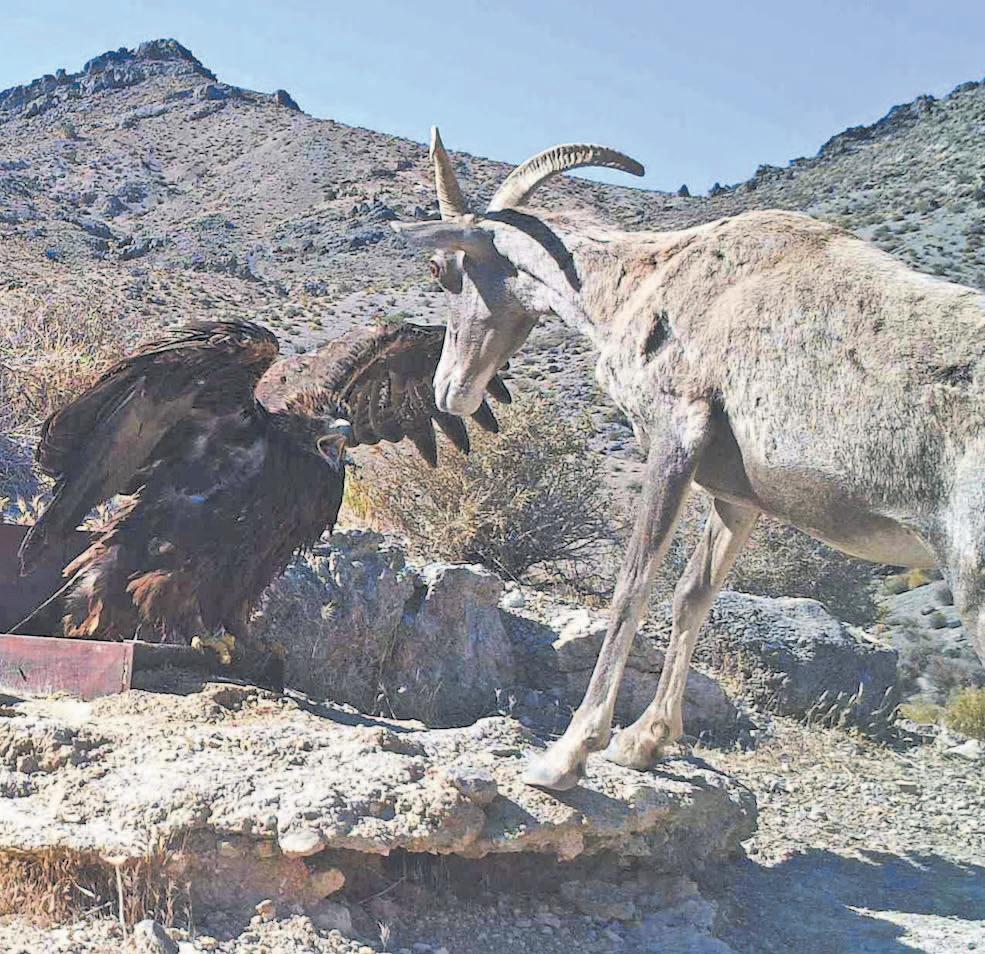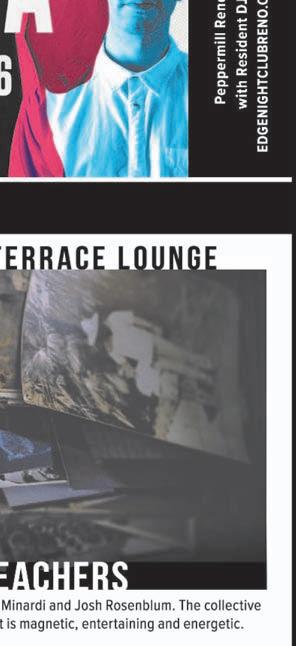
7 minute read
NEWs
from July 3, 2019
Headlines of tHe week
Bloomberg News: “Buffett’s Nevada Utility Offers One Customer Millions to Stay”
Advertisement
Green Entrepreneur: “Pot Smokers in Nevada No Longer Need to ‘Study’ for That Pre-Employment Drug Test”
andrea engleman 1940-2019
The leading expert on Nevada’s open meeting and open records laws died on June 12.
Born in Los Angeles and raised in both California and D.C., Andrea Engleman eventually took her first journalism job in the nation’s capital at WTOP, now WUSA. Returning to the West, she settled in Carson City.
She worked in journalism for Reuters, KOLO News and a political newsletter. From 1984-1987, she served as an agency chief in Gov. Richard Bryan’s administration and later became the spokesperson for the secretary of state’s office. Later in her career, she was a commentator on Nevada Newsmakers. She recently chaired the Carson City Utility Finance Oversight Committee.
In 1983, she became manager of the Nevada Press Association office, beginning her immersion in public access issues. She departed the association for a time but came back and expanded the job into an executive director’s post.
She learned the ins and outs of press law intimately, sometimes coaching lawyers on the issues and jumping into frays that did not initially seem like open government disputes but which were later shown to engage public access. Assertive and sometimes abrasive, she seldom conceded anything if the public’s access was involved.
She went over legislation with a fine toothed comb, often spotting problems lawmakers had to fix. In an article for the RN&R in 2005, she wrote of one measure, “There’s also a more basic sentence structure problem with the new law—the phrase ‘knowing such report to be false’ appears, but because of the tortured 57-word sentence in which it is located, it refers to the police instead of a complainant.”
“Ande had a unique ability to take complex subjects and make them understandable to the general public,” said her colleague Sam Shad. “That was quite a gift.”
In learning she was dying in April, Engleman told a friend in an email, “Have a few months after I start chemo. Hope someone will look out for open government because the Dems are closing it all down.”
She warned against 2019 legislation drafted by the state Open Meeting Law Task Force.
In her last weeks, she underwent some chemotherapy, but only, she said, to buy herself a little time to put her affairs in order.
“Thank goodness it’s not dementia! I want a quality of life and that’s my choice :-) Can’t keep food down so am getting weaker and weaker. Chemo is just [to] ensure I have a month to get things wrapped up. :-).”
—Dennis Myers
This photo of an angry eagle facing off with a bighorn sheep was used with an AP story on the Desert National Wildlife Refuge.
PHOTO/U.S. FISH AND WILDLIFE SERVICE
Nevada refuge in spotlight
Planned inroads draw wide opposition
the Pentagon’s plans to carve out more of the Desert National Wildlife Refuge in Nevada are facing more and more scrutiny.
At public hearings in March, not one member of the public supported the idea. The Nevada Legislature has enacted a resolution in opposition, and press scrutiny is intense, including a lengthy piece in the New York Times last week that reported, “In a state increasingly described as politically purple, both Republicans and Democrats have spoken out against the expansion of the Air Force range, and it has become the rare issue that unites voices as diverse as the Sierra Club and the most conservative lawmakers in the state.”
The Air Force proposal would take another chunk of the Refuge into the Nevada Test and Training Range, a bombing and gunnery facility that occupies 4,531 square miles of the state. That figure already includes about half the Refuge.
Notwithstanding modern miniaturization and claimed precision of new weapons, the Air Force says it needs additional land to test such weapons— and to allow U.S. allies to do the same.
“Since enemy technology has become increasingly advanced and complex, more space is needed to replicate threat configurations,” said the Air Force in an environmental impact statement.
The Refuge was established on May 20, 1936. The adjoining military facility came into being in 1940. A year later, about 38 percent of the gunnery range was allowed to overlap with the Refuge. Then, during the Vietnam war, more than 70 percent of the refuge was carved out for military use. Now, another 225,000 acres is on the block.
Nevada has long been a favored site of the federal government for projects other states do not want. A sampling:
Dec. 5, 1913: U.S. Secretary of the Interior Franklin Lane announced that President Woodrow Wilson had approved withdrawal from public use of about 4,500 acres of land in the basin of the Owyhee River.
Feb. 23, 1937: President Franklin Roosevelt signed an executive order withdrawing from public use land in Nevada to be used for erosion control demonstrations. (The order was revoked on September 27, 1965.)
Oct. 29, 1941: Six weeks before Pearl Harbor, President Roosevelt signed executive order 8927, withdrawing Nevada public lands from public use for the gunnery range.
Feb. 11, 1958: President Dwight Eisenhower signed an executive order withdrawing from public use airspace for “an airspace reservation” over facilities of the Atomic Energy Commission, and over Groom Lake.
Such takings sometimes drew criticism, as when Nevada Surveyor General Wayne McLeod criticized repeated federal “withdrawals” of public land in the state. His comments were exquisitely if inadvertently illtimed. He made them on Dec. 6, 1941.
But, generally, Nevada officials until late in the 20th century welcomed many federal projects, however disagreeable, as economic development. But beginning in the 1970s, the public’s opposition to nuclear activities became common, as well as greater environmental concern.
The new effort to shrink the Desert National Wildlife Refuge has drawn remarkably broad opposition inside the state and is attracting growing attention outside. The Associated Press, the world’s largest press organization, sent out a long story a few weeks ago— accompanied by a dramatic photo at the refuge—that was picked up in numerous newspapers as well as special interest sites from the Air Force Times to Business Breaking News (which posted the piece under the section title “Weapons for spiritual warfare”).
Outdoor Life magazine ran a piece emphasizing the efforts of volunteers and wildlife officials in getting rainwater to wildlife on the Refuge during droughts.
Beatty encroachment?
High Country News, in an article re-posted by Mother Jones magazine, managed to slip a mention of the refuge into an article on Mexico border policies:
“In southern Nevada, where the Mojave meets the Great Basin Desert, two US Fish and Wildlife Service law enforcement officers are responsible for patrolling the entire Desert National Wildlife Refuge complex. Their job comes with a diverse set of responsibilities: enforcing hunting and fishing regulations, stopping park vandalism and rescuing stranded visitors, among other things. At 1.6 million acres, this is the largest wildlife refuge in the country outside of Alaska, home to over 500 plant species and the desert bighorn sheep, Nevada’s state animal. So why are these two officers being sent hundreds of miles away from the refuge on rotating missions to the US-Mexico Border?” (Rangers from Lake Mead National Recreation Area and Death Valley National Park were also sent to the border.)
Wild Sheep Foundation chair Brett Jefferson says the refuge—which also has tribal petroglyphs—was established to protect the bighorns, but it doesn’t stop there:
“Desert bighorn are not the only species dependent upon these water installations. So are 67 other species of wildlife, including mountain lions, mule deer, birds and reptiles. Cutting off access to Alamo Road would prevent proper management by wildlife professionals and conservationists.” One Renoite, Kirk Peterson, suggested in a letter to the editor of the Las Vegas Sun that the problem be taken over by Texas. “About 6 percent of Nevada’s land is used for national security,” he wrote. “In Texas, that number is 0.3 percent. … In the 1980s, West Texas was determined to be ideal for national security use, given that there was low or no significant impacts on mining, wildlife, native species, wildlife
“More space habitat or public recreation—all issues of significance in is needed to Nevada.” replicate threat By the time of the deadline configurations.” for public comments in March, more than 30,000 people had
U.S. Air Force filed one. The Nevada Legislature’s resolution opposed more than just the reduction of the Refuge: “The final legislative environmental impact statement also includes proposals that the United States Air Force designates as ‘Alternative 3A’ and ‘Alternative 3A-1’ to withdraw either 18,000 or 15,000 acres of land outside the Desert National Wildlife Refuge, but near the town of Beatty, for incorporation into the Nevada Test and Training Range, which would result in substantial encroachment on the town of Beatty and result in significant negative impacts to the local economy, including losses of revenue from existing and planned trails, ecotourism activities and mining.” The agreement allowing use of the Refuge by the military expires in two years. Ω
Flag waving

















